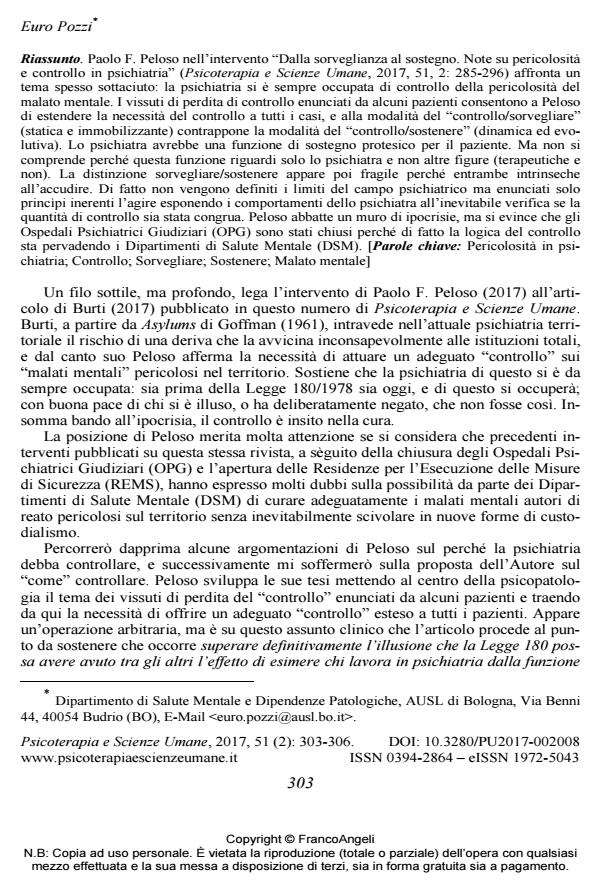Interventi
Journal title PSICOTERAPIA E SCIENZE UMANE
Author/s Euro Pozzi
Publishing Year 2017 Issue 2017/2
Language Italian Pages 4 P. 303-306 File size 31 KB
DOI 10.3280/PU2017-002008
DOI is like a bar code for intellectual property: to have more infomation
click here
Below, you can see the article first page
If you want to buy this article in PDF format, you can do it, following the instructions to buy download credits

FrancoAngeli is member of Publishers International Linking Association, Inc (PILA), a not-for-profit association which run the CrossRef service enabling links to and from online scholarly content.
Commentary on Paolo F. Peloso’ paper "From surveillance to support. Some notes on dangerousness and control in psychiatry" (Psicoterapia e Scienze Umane, 2017, 51, 2: 285-296). Paolo F. Peloso discusses an important and often unspoken issue: psychiatry has always dealt with the control of mental patients’ dangerousness. The patients’ feelings of loss of control allow Peloso to extend the need of control to all patients. In place of a modality of "control/surveillance" (which is immobilizing), he suggests a modality of "control/support" (which is dynamic). The psychiatrist should have a prosthetic function for the patient. However, it is not clear why this function should belong only to the psychiatrist and not also to other mental health professionals. Furthermore, the distinction between surveillance and support is unconvincing because both are part of the treatment process. The boundaries of psychiatry are not clearly defined; only some general principles are spelled out, with the result that the psychiatrist is left with the difficulty of verifying how much control is needed. Peloso surely reveals a common hypocrisy, but it is possible that Forensic Psychiatric Hospital in Italy have been closed because the idea of control is already pervasive in Community Mental Health Centers.
Keywords: Dangerousness in psychiatry; Control; Surveillance; Support; Mental patient
- Diario della psicoterapia di Federico (1955-56) Berta Neumann, Eugenia Omodei Zorini, in PSICOTERAPIA E SCIENZE UMANE 3/2019 pp.417
DOI: 10.3280/PU2019-003003 - "Ritorno a Basaglia": una prospettiva possibile per la salute mentale? "Back to Basaglia": A possible perspective for mental health? Paolo Francesco Peloso, in PSICOTERAPIA E SCIENZE UMANE 4/2022 pp.593
DOI: 10.3280/PU2022-004005 - Dibattiti. Alcuni chiarimenti a proposito di pericolosità e controllo in psichiatria Paolo Francesco Peloso, in PSICOTERAPIA E SCIENZE UMANE 3/2017 pp.447
DOI: 10.3280/PU2017-003008 - Dieci problemi per una reale riforma della salute mentale Andrea Angelozzi, in PSICOTERAPIA E SCIENZE UMANE 3/2019 pp.481
DOI: 10.3280/PU2019-003006 - Dibattiti. Senza scienza e senza cultura. Riflessioni sulle riforme in salute mentale Andrea Angelozzi, in PSICOTERAPIA E SCIENZE UMANE 1/2019 pp.107
DOI: 10.3280/PU2019-001006
Euro Pozzi, Interventi in "PSICOTERAPIA E SCIENZE UMANE" 2/2017, pp 303-306, DOI: 10.3280/PU2017-002008